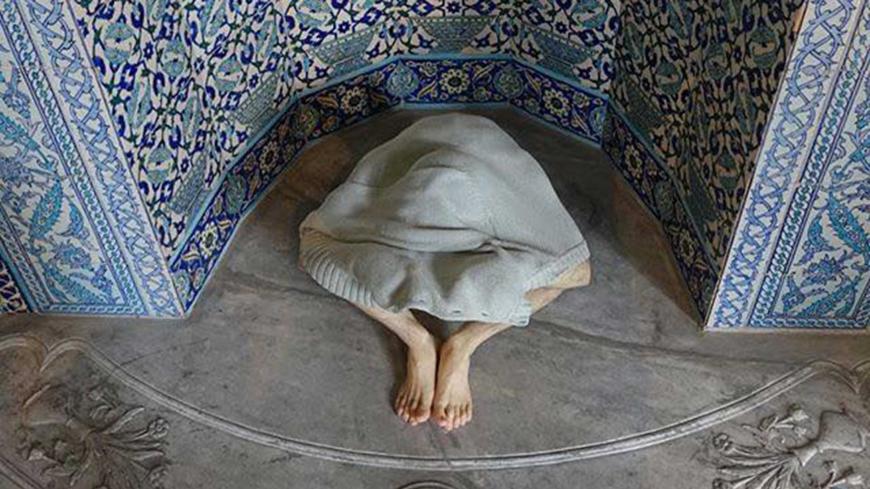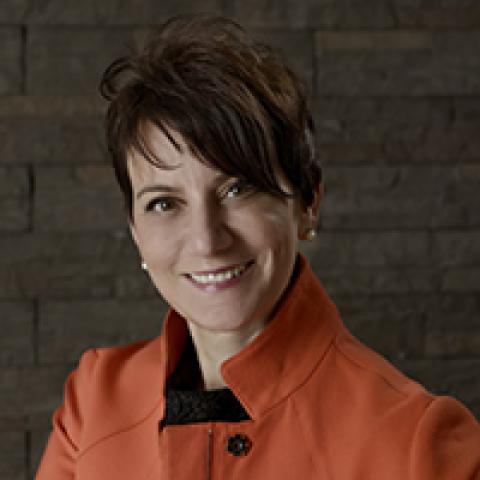ISTANBUL — The narrow path surrounded by trees leading to the Abdulmecid Efendi Kiosk lends an air of calm and serenity on a gray autumn day in Istanbul, making it hard to believe that the estate had been the scene of vandalism in prior weeks. “Doors Open To Those Who Knock,” a contemporary art exhibition at the 19th-century pavilion, was attacked by vandals set on destroying artwork. The episodes took place after a social media campaign to remove “obscene statues” from the estate house once owned by the last Ottoman caliphate, Abdulmecid Efendi, who was also a painter whose works included a painting with nudes in a courtyard.
“The exhibition [sponsored by] Koc Holding at the house of the caliphate should stop. … This is a disgrace under the name of art,” tweeted Nilhan Osmanoglu, a descendant of the Ottoman dynasty and poster girl for the Ottomania of the ruling Justice and Development Party (AKP). According to conservative media, the exhibition shows “disrespect for the caliphate and believers.”
Curated by Melih Fereli and Karoly Aliotti, the exhibition consists of 30 works from the legendary private collection of the business mogul Omer Koc. It was organized as a satellite event of the 15th Istanbul Biennial, the major contemporary art exhibition, which Koc Holding sponsors. Among the works on display are a self-portrait by Taner Ceylan, whose artwork focuses on homosexuality, violence and reinterpretation of stereotypes, and a sculpture of a dead swan by Daphne Wright positioned masterfully next to a marble basin with a fountain in the tiled foyer.
The main target of attack was the statue “Man Under Cardigan,” by the Australian artist Ron Mueck. The piece is a work of hyperrealism on loneliness, which is conveyed in the representation of a nude man sitting Turkish style and appearing to hide beneath a cardigan that covers his head and shoulders.
Some opposed to its display claimed that the statue was situated in a mihrab, the niche that indicates the direction of Mecca in a mosque. A statement from Koc Holding explained that what they claimed to be a mihrab was actually once a fireplace that faced southwest, while mihrabs face southeast. The statement further noted, “The house has never been used as a place of worship or a religious venue in its history.”
On Oct. 21, Mahmut Alan picked up the statue and threw it to the floor in an unsuccessful attempt to smash it. A former member of the ultranationalist Great Unity Party, Alan was arrested and later explained his actions in a video. “Just because [Omer Koc] has got money, that does not mean he can display genitals right where our children can see them,” he said. “I call on the president and all politicians to stop this shamelessness.”
“The attack is shameful, just shameful,” Tulay Akin, a housewife visiting the exhibition, told Al-Monitor. Next to her, two young girls in headscarves giggled as they snapped selfies near the statue, now protected by two security guards.
Turkey is home to numerous ancient sculptures that pre-date Islam, among them the ancient stone heads on Mount Nemrud and the statue of the hunter goddess Diana/Artemis in Ephesus. Islam prohibits the production of facial images and sculptures, associating them with idols and idolatry. The historian Philip Mansel claims in his book “Constantinople” that only three figurative statues were erected in the Ottoman capital between its conquest in 1453 by the Muslim Turks and the empire's demise in the early 1920s.
The statues in question belonged to Ibrahim Pasha, the brother-in-law and grand vizier of Suleiman the Magnificent. A Christian convert to Islam, the unorthodox Ibrahim brought statues of Hercules, Apollo and Diana from Hungary and installed them in a public square in front of his residence. When a poet, Figani, accused him of erecting idols, Ibrahim had him executed in 1532. Neither Ibrahim’s influence nor his statues, however, lasted very long. A few years later, in 1536, Suleiman executed his vizier for plotting with Western enemies against his empire, and the statues were smashed.
The tradition of erecting statues in public squares took root in Turkey during the early republic, mostly in the form of representations of modern Turkey's founder, Kemal Ataturk, and homages to the country's independence. Also indicative of changing attitudes toward European-style sculpture, Rudolf Belling, a German sculptor from Berlin, was invited in 1937 to head the Department of Sculpture at the Fine Arts Academy in Istanbul.
“But [attempts by the early republic to put sculptures in public areas] often faced backlash from conservative groups,” Erdal Duman, a sculptor and academic at Hacettepe University's Department of Sculpture, told Al-Monitor. Highlighting one such instance, he explained, “Two naked statues, which were made in 1938 by Austrian sculptor Heinrich Krippel, were originally planned to be displayed in one of the public squares in Ankara. In the 1950s, they were [instead] placed in front of Gazi University’s School of Fine Arts. Then they were placed inside the building. Finally, in 2013, they were removed altogether.”
Many public statues, particularly those with even a hint of nudity or sexuality, have gradually been removed from public spaces by censorious local authorities. Melih Gokcek, Ankara’s mayor for 23 years until resigning Oct. 28, took down Mehmet Aksoy’s “At the Country of Fairies,” two female figures intertwined in a dance. He did so immediately after being elected in 1994, calling the statue obscene. “If this is art, I'd spit on it,” he said. Aksoy sued Gokcek, and the statue was reinstalled in 2002 bearing damage done to it. “It seems that the statue has outlived Gokcek after all,” Aksoy told al-Monitor by phone.
Many public statues, particularly those with even a hint of nudity or sexuality, have gradually been removed from public spaces by censorious local authorities.
The "Water Nymphs," an Italian, Romantic-style bronze depicting bare-breasted water carriers, also suffered the wrath of Gokcek. Brought from Italy in 1924, the statue was temporarily removed from Tandogan Square in 1992 while the area underwent reconstruction. Gokcek simply refused to restore it. In 2010, it found a home in the newly opened museum CerModern. A giant teapot, cup and saucer now stand in the nymphs' place. During his tenure, Gokcek also decorated the capital with dinosaur statues, giant cats and Robocop figures.
“This government and their men have no sense of aesthetics when it comes to statues,” Aksoy, an outspoken critic of the current government, said. “The statues they put up are like cartoon figures. They wanted to make statues to honor the heroes of July 15 [the failed coup], and one was so hideous that the president [Recep Tayyip Erdogan] ordered it to be removed,” referring to Harran, a town in the southeast whose municipality wanted to erect a statue of Erdogan stopping a tank with a gesture of his hand.
Aksoy himself came under fire from Erdogan in 2011, when as prime minister Erdogan ordered the removal of Aksoy’s “Monument to Humanity,” a statue in Kars of two thin figures facing each other in an homage to Turkish-Armenian friendship. Aksoy again sued and won. The monument could not be replaced, however, because it had been destroyed.
“If the government ignores, belittles or insults any form of art, particularly sculpture, their supporters or some members of the public find it easy to take an ax and smash what they do not like,” Duman told Al-Monitor. “There have been numerous attacks on public statues, for political reasons, on grounds of obscenity or simple vandalism. Most have gone uninvestigated, let alone punished.”
Last year, Contemporary Istanbul, another international art event, was raided by a group of conservatives who demanded the removal of a bikini-clad statue by Ali Elmaci because a portrait of Sultan Abdulhamid II, revered by conservatives in Turkey, appeared on its belly. The statue was removed. There have also been numerous attacks on art in public places. Earlier this year in the northern city of Zonguldak, vandals smashed a statue of a girl offering flowers to Kemal Ataturk. In 2016, in the Aegean port city Izmir, a man took an ax to “The Musician” after local AKP politicians launched a campaign to remove the statue, claiming that its nakedness offended women and children passersby.
In the last few years, several statues in public spaces have cautiously been moved indoors. Yapi Kredi Bank’s “Akdeniz” (Mediterranean), a statue by Ilhan Koman symbolically melding women and the sea, once stood in front of the bank’s office in the Levent district and then on Istiklal Street, in the heart of Istanbul. It is now on the third floor of the bank’s cultural center, looking down on the street.
“This statue, by one of the greatest Turkish sculptors, belongs in an open space, not indoors,” lamented Aksoy. “But at least it is intact.”







